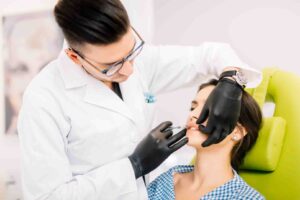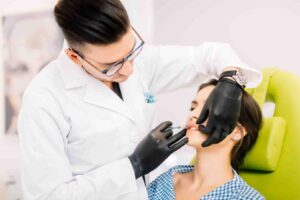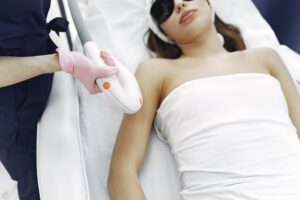Reduce red marks: #1 Ultimate Guide to Clear Skin
Why Red Marks After Acne Are So Persistent (And What You Can Do About Them)
Reduce red marks from acne by following these evidence-based steps:
- Protect from sun – Apply broad-spectrum SPF 30+ daily and reapply every 2-3 hours
- Use targeted ingredients – Incorporate niacinamide, salicylic acid, or azelaic acid into your routine
- Never pick – Avoid touching, popping, or squeezing pimples to prevent deeper inflammation
- Exfoliate gently – Use chemical exfoliants (AHAs, BHAs) 1-2 times weekly
- Be patient – Most red marks fade naturally in 3-6 months with consistent care
- Consider professional help – If marks persist beyond 2 weeks or worsen, consult a dermatologist for treatments like IPL or laser therapy
After a breakout clears, you’re often left with frustrating red marks that can linger for weeks or months. This common issue is known as post-inflammatory erythema (PIE), a natural response to inflammation where blood vessels remain dilated after a pimple has healed.
The good news is that these marks are not permanent scars, and you have options to speed up their departure. From targeted at-home ingredients to professional treatments, a clearer, more even-toned complexion is achievable.
I’m Dr. Sarah Yovino, a double board-certified specialist at Ideal Face & Body in Beverly Hills, CA. My expertise in facial rejuvenation using lasers, chemical peels, and advanced skincare has helped many patients effectively reduce red marks and regain their confidence.
Understanding the Enemy: What Are Post-Acne Red Marks?
When acne causes inflammation, your skin increases blood flow to the area to fight bacteria and repair damage. The persistent red marks left behind are called post-inflammatory erythema (PIE). This occurs because the tiny blood vessels (capillaries) that dilated during the breakout don’t immediately return to their normal size.
The severity of the initial inflammation determines how long these marks last; a deep, cystic lesion will leave a more persistent mark than a small pimple. Sun exposure also hinders the healing process, keeping blood vessels dilated longer. This is why sunscreen is essential to reduce red marks.
Red Marks vs. Acne Scars: Knowing the Difference
It’s crucial to know if you’re dealing with a mark or a scar, as treatments differ. Post-acne marks (PIE/PIH) are flat discolorations. They are temporary and feel smooth to the touch because there is no change in skin texture.
True acne scars, however, involve a permanent change in skin texture that you can feel. These occur when the healing process is disrupted. Atrophic scars are indented due to a loss of collagen and include ice pick, boxcar, and rolling scars. Hypertrophic scars (and their more aggressive cousins, keloids) are raised bumps caused by an overproduction of tissue. Understanding this difference is the first step toward choosing the right solution.
The Lifecycle of a Red Mark: How Long Do They Last?
How long do red marks last? The timeline varies. Superficial marks may fade in 3-6 weeks, but marks from deeper inflammation like cystic acne can persist for 6-12 months or longer. Several factors influence this:
- Severity of Inflammation: Deeper breakouts leave more persistent marks.
- Skin Tone: Red marks (PIE) are often more visible on lighter skin.
- Sun Exposure: UV rays slow down the healing process, prolonging redness.
- Picking: Squeezing pimples increases trauma and extends recovery time.
- Consistency of Care: A dedicated routine with targeted ingredients significantly accelerates fading compared to waiting it out.
Patience is key, but a consistent approach delivers the fastest results.
Your At-Home Toolkit: How to Reduce Red Marks with Skincare
A consistent at-home skincare routine can make a remarkable difference when you want to reduce red marks. The foundation is built on gentleness, using non-comedogenic (won’t clog pores) products, and daily sun protection. Your goal is to soothe inflammation, support healing, and prevent further damage.
The Best Ingredients for Fading Redness
When shopping for products to reduce red marks, look for these research-backed ingredients:
- Niacinamide: A form of vitamin B3 that reduces inflammation and strengthens the skin barrier. Explore the scientific research on Niacinamide’s benefits.
- Salicylic acid: A BHA that exfoliates within the pore to clear debris and calm irritation. See this study on Salicylic Acid’s properties.
- Azelaic acid: A gentle acid that reduces inflammation, kills acne bacteria, and evens skin tone.
- Vitamin C: An antioxidant that brightens skin, stimulates collagen, and helps prevent redness.
- Retinoids: Vitamin A derivatives that accelerate cell turnover to speed up the fading process.
- Alpha-hydroxy acids (AHAs): Glycolic and lactic acids exfoliate the skin’s surface to reveal brighter skin.
- Centella Asiatica (Cica): A soothing botanical extract that calms inflammation and promotes healing.
Building a Skincare Routine to Reduce Red Marks
Consistency is key to seeing results. A simple, effective routine is all you need.
Morning:
- Cleanse: Use a gentle, fragrance-free cleanser.
- Treat: Apply a niacinamide or vitamin C serum to calm and protect.
- Moisturize: Use a lightweight, non-comedogenic moisturizer.
- Protect: Finish with a broad-spectrum SPF 30+ sunscreen. This is non-negotiable.
Evening:
- Cleanse: Thoroughly remove makeup and sunscreen.
- Treat: Apply a retinoid or a serum with salicylic or azelaic acid to accelerate cell turnover and reduce inflammation.
- Moisturize: Lock in hydration to support skin repair.
Weekly: Use a gentle chemical exfoliant (AHA/BHA) once or twice a week. For improved efficacy, consider Medical Grade Skincare options.
Quick Fixes and Camouflage for Immediate Results
For immediate improvement, try these quick fixes.
- Ice: Wrap an ice cube in a cloth and apply it to an inflamed mark for up to 10 minutes to constrict blood vessels and reduce redness.
- Pimple patches: These protect the area from picking and can deliver targeted ingredients like salicylic acid.
- Green-tinted concealer: Based on color theory, green neutralizes red. Dab a small amount onto the red mark, blend, and then cover with a skin-toned, non-comedogenic concealer.
Prevention Is Better Than Cure: How to Stop Marks Before They Start
The best way to reduce red marks is to prevent them. This requires a proactive approach to treating acne and caring for your skin daily. Address breakouts early with targeted treatments to minimize inflammation. Avoid harsh physical scrubs, which can worsen inflammation and prolong healing; opt for gentle chemical exfoliants instead.
The “Hands-Off” Policy and Why It Matters
It’s tempting, but picking or squeezing pimples is one of the worst things you can do. This action causes trauma, spreads bacteria, and pushes inflammation deeper into the skin, leading to more prominent red marks and increasing the risk of permanent scars. The American Academy of Dermatology confirms that a hands-off approach is essential for preventing scars. You can read more in the AAD advice on preventing scars.
Sunscreen: Your Non-Negotiable Daily Shield
Daily sunscreen use is the single most important step in preventing and treating post-acne marks. UV radiation effects on healing skin are significant. It interferes with the healing process, prolonging redness, and directly causes darkening of marks (PIH), making them harder to treat.
Use a broad-spectrum SPF of at least 30 every morning as the last step of your routine. Reapplication importance cannot be overstated; reapply every two to three hours if you are outdoors, sweating, or swimming to maintain protection.
When to Escalate: Professional Treatments for Stubborn Marks and Scars
If your red marks persist despite a consistent at-home routine, or if you suffer from painful, cystic acne, it’s time to seek professional help. A specialist can provide an accurate diagnosis—distinguishing acne from conditions like rosacea—and offer more powerful treatments. The American Academy of Dermatology offers guidance on differentiating from rosacea. At Ideal Face & Body in Beverly Hills, Dr. Sarah Yovino and Dr. Justin Yovino create personalized treatment plans to address your specific concerns.
Advanced Treatments to Reduce Red Marks
For stubborn post-inflammatory erythema (PIE), we target the underlying dilated blood vessels with advanced treatments.
- Chemical Peels: Professional-grade solutions remove damaged top layers of skin, revealing healthier skin and improving redness.
- Intense Pulsed Light (IPL): This technology uses broad-spectrum light to selectively target and eliminate the blood vessels causing redness, without harming surrounding tissue. Our IPL treatments are highly effective for creating even-toned skin.
- Pico Way Laser: This cutting-edge laser uses ultra-short energy pulses to break down pigment, stimulate collagen, and reduce red marks, discoloration, and overall skin texture in one powerful treatment.
Tackling True Acne Scars: From Atrophic to Hypertrophic
Textural scars require a different approach to remodel the skin. We specialize in treating all types of acne scars at Ideal Face & Body.
For Atrophic (Indented) Scars:
- Microneedling: This treatment stimulates new collagen to fill in indentations from below. We offer specialized Microneedling for Scar Treatment, including for Microneedling Boxcar Scars.
- PRP (Platelet-Rich Plasma) Facials: Our PRP Facial uses your body’s own growth factors with microneedling to boost collagen production and scar repair.
- Dermal Fillers: Can provide immediate results by lifting depressed scars to be level with the surrounding skin.
For Hypertrophic (Raised) Scars:
- Corticosteroid Injections: Help flatten and soften raised scar tissue.
- Laser Resurfacing: Our CO2 Laser Resurfacing treatment removes damaged outer skin layers and stimulates deep collagen remodeling to significantly improve scar texture.
- Microneedling: Can also be adapted to help remodel and soften raised scars, as detailed in our guide to Microneedling Hypertrophic Scars.
At Ideal Face & Body, we will determine the best combination of treatments for your unique scar type, including options like our Dermaroller for Scars treatment.
Frequently Asked Questions
Can natural remedies really help fade red marks?
While some natural remedies have beneficial properties, their effectiveness for fading red marks is often limited compared to scientifically-backed ingredients.
- Tea tree oil has anti-inflammatory properties but must be diluted and can cause irritation, as noted by the American Academy of Dermatology on tea tree oil.
- Aloe vera is soothing but lacks strong evidence for accelerating mark fading.
- Rosehip oil has shown promise in some research on rosehip oil for scars, but not specifically for acne marks.
Overall, ingredients like niacinamide and retinoids are more reliable. If you try natural remedies, always perform a patch test first to check for irritation.
How does microneedling work for different types of scars?
Microneedling, or collagen induction therapy, uses fine needles to create controlled micro-injuries in the skin. This process triggers the body’s natural healing response, stimulating the production of new collagen and elastin. For atrophic (indented) scars, this new collagen helps fill in depressions, creating a smoother surface. We offer targeted treatments like Microneedling Boxcar Scars. For hypertrophic (raised) scars, the process helps remodel disorganized collagen fibers, which can soften and flatten the scar tissue. You can learn more about our approach to Microneedling Hypertrophic Scars. The treatment promotes overall skin remodeling, improving tone and texture. Explore our comprehensive Microneedling for Scar Treatment page for more details.
Will red marks from acne ever go away permanently?
Yes, the red marks from post-inflammatory erythema (PIE) are temporary and will eventually fade. The natural fading process can take anywhere from a few weeks to over a year, depending on the severity of the initial inflammation. At-home care and professional treatments don’t perform a miracle; they accelerate this natural process. It’s important to distinguish these temporary, flat marks from permanent, textured true acne scars, which do not go away on their own and require professional treatment to improve their appearance. The AAD on scar treatment confirms that while scars are permanent, treatments can significantly improve them.
Conclusion: Your Path to Clearer, Even-Toned Skin
Dealing with red marks after acne can be frustrating, but you have the power to improve your skin. The key is understanding that most marks are temporary post-inflammatory erythema (PIE), not permanent scars.
Your path to clearer skin is built on three principles: understand the cause, treat consistently with proven ingredients, and prevent new marks by adopting a hands-off policy and using daily sunscreen. Patience and consistency are your greatest allies; progress takes time, but it will happen.
For stubborn marks or true textural scars that don’t respond to at-home care, professional treatment can make a dramatic difference. At Ideal Face & Body in Beverly Hills, CA, Dr. Sarah Yovino and Dr. Justin Yovino offer expert, personalized treatment plans. Using advanced technologies like Pico Way lasers, microneedling with PRP, and CO2 laser resurfacing, we can help you achieve your skin goals.
Ready to take the next step? Explore advanced scar treatments like Dermaroller and find how our expertise can help you achieve the clear, even-toned complexion you deserve. Your path to confident, radiant skin starts with understanding, continues with consistent care, and can be accelerated with the right professional guidance.










